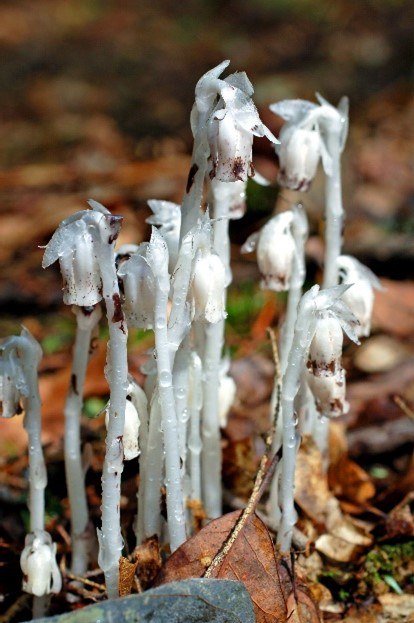Posted: June 2, 2023

Exploring ghost pipe, a secretive and elusive medicinal plant found on Pennsylvania forestlands
Exploring ghost pipe, a secretive and elusive medicinal plant found on Pennsylvania forestlands
Plants have been providing humans around the world with medicine for thousands of years. These medicinal plants are so potent that their chemicals have formed the basis of our modern pharmaceuticals today. Medicinal plants are still a powerful source for the discovery of new treatments, but of the tens of thousands of plants with a documented ethnobotanical use, only a fraction of them have had their specific biochemistry studied. Ghost pipe, a parasitic plant native to Pennsylvania with a long history of traditional medicinal use, is not yet a part of that small fraction. The first part of my study seeks to address this knowledge gap by characterizing the specific chemistry and medicinal activity of ghost pipe (Monotropa uniflora). The experiments I conduct to test these properties will be directly guided by a public survey documenting the traditional folk uses of this plant, promoting science that is guided by traditional knowledge, and a community connection with which to share the scientific properties we discover.
Additionally, ghost pipe also has a unique ecological relationship with other organisms of the forest. Ghost pipe is a specific kind of parasite known as a mycoheterotroph, a parasite which draws its nutrients from mycorrhizal fungi in the soil. Since we know that mycorrhizal fungi form a common symbiotic network between multiple species of the forest, and that the chemical composition of a parasitic plant changes significantly depending on their host, the question of its biochemical consistency, and thus its medicinal efficacy, is more complex than a typical green, non-parasitic plant. The second part of my study seeks to understand how differences in primary and secondary host species affects the chemical profile of ghost pipe, and how that in turn affects its medicinal properties. Furthermore, this study will develop ghost pipe as a model for plant parasitism of fungi, shedding much-needed light on how these plants chemically interact with their hosts’ environment.
As a PhD student at Penn State, I am studying ghost pipe to document its current folk uses, to characterize the biochemistry and medicinal activity of ghost pipe, and to investigate to what extent these properties are affected by host species and local environment. These study goals require me to survey and sample ghost pipe from a wide range of locations across its native range. As such, I am looking for any information on potential locations in which ghost pipe can be found. Whether you are a private forest landowner or happen to know of ghost pipe on public lands, any information you would be willing to share with me would be greatly appreciated as I look to determine how different environments and different host species affect the chemical composition of this plant. To date, I have sampled ghost pipe from sites in central Pennsylvania. If you are willing to share a potential ghost pipe sample location or would like to find out more about the study, please email me (Savannah Anez) at sga5169@psu.edu. Additionally, if you use or forage ghost pipe, please consider completing my survey, which can be found at https://sites.psu.edu/ghostpipestudy/.
James C. Finley Center for Private Forests
Address
416 Forest Resources BuildingUniversity Park, PA 16802
- Email PrivateForests@psu.edu
- Office 814-863-0401
- Fax 814-865-6275
James C. Finley Center for Private Forests
Address
416 Forest Resources BuildingUniversity Park, PA 16802
- Email PrivateForests@psu.edu
- Office 814-863-0401
- Fax 814-865-6275

